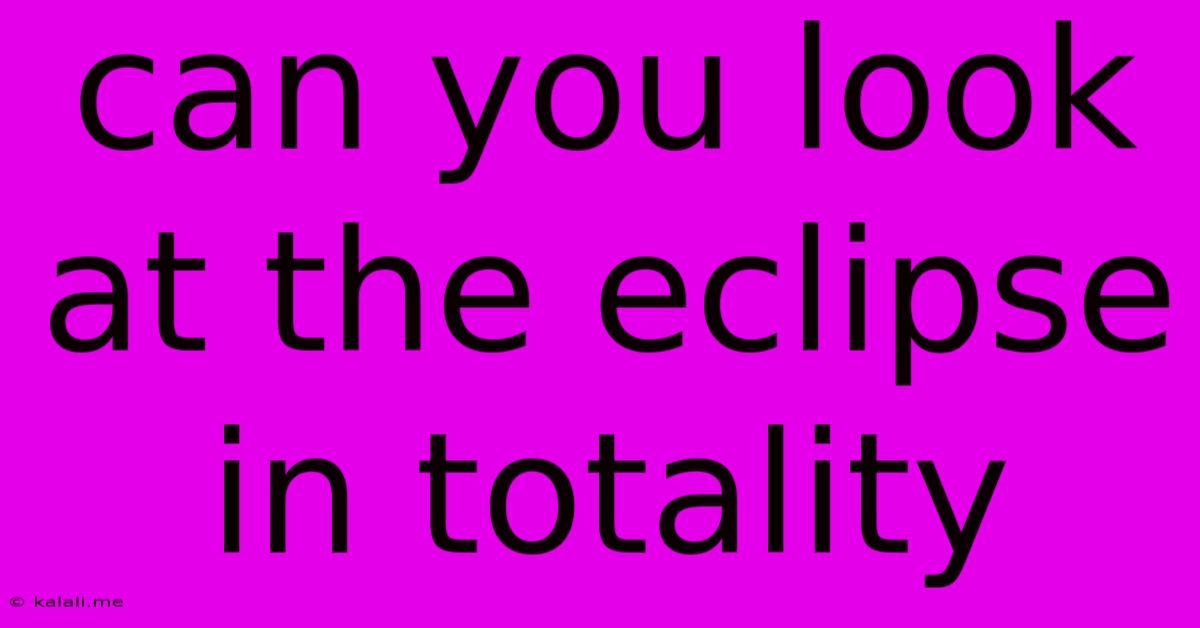Can You Look At The Eclipse In Totality
Kalali
Jun 08, 2025 · 3 min read

Table of Contents
Can You Look at the Eclipse in Totality? A Guide to Safe Solar Viewing
A total solar eclipse is a breathtaking celestial event, a moment when the moon completely obscures the sun, revealing the sun's ethereal corona. But the question on everyone's mind is: Can you look at the eclipse in totality? The short answer is: yes, but only during the brief period of totality. Looking at the partially eclipsed sun, even for a second, can cause serious and permanent eye damage.
This article will guide you through the safety precautions and explain why looking at the sun during totality is different from looking at it during partial eclipse phases.
Understanding the Dangers of Looking at the Sun
The sun emits incredibly intense light and radiation, including ultraviolet (UV) and infrared (IR) rays. Even when partially obscured, this radiation can damage the retina, the light-sensitive tissue at the back of your eye. This damage can lead to solar retinopathy, causing blurred vision, blind spots, and in severe cases, permanent vision loss. There's no pain associated with this damage, making it even more dangerous. Never look directly at the sun without proper eye protection, regardless of how tempting it may seem.
Why Totality is Different
During the total phase of a solar eclipse, the sun's disk is completely blocked by the moon. This brief period (lasting only a few minutes at most) is the only time it is safe to look directly at the eclipse without eye protection. The intense light and radiation are completely blocked by the moon, allowing you to witness the corona and other solar phenomena without risking eye damage. However, the moment partial eclipse begins again, you must immediately put on your solar glasses or other approved eye protection.
Safe Solar Viewing Practices:
- Use certified solar filters: These are special glasses or filters that drastically reduce the sun's brightness and radiation. Make sure they meet the ISO 12312-2 international safety standard. Improvised filters, such as sunglasses or exposed film, are not safe and should never be used.
- Never use binoculars or telescopes without certified solar filters: These devices concentrate the sun's rays, increasing the risk of severe eye damage. Attach a certified solar filter to the front of the device.
- Supervise children carefully: Children are especially vulnerable to solar retinopathy. Ensure they use certified solar filters and are supervised at all times.
- Be aware of the phases of the eclipse: Keep track of the timing of the partial and total phases to know when it is safe to look without protection. Your local astronomy club or NASA website will provide precise timings for your location.
- Indirect viewing: A safe and enjoyable way to observe the eclipse is through indirect methods like using a pinhole projector or watching a live stream.
Enjoying the Totality Safely
Witnessing a total solar eclipse is an unforgettable experience. By following these safety guidelines, you can enjoy this amazing natural phenomenon without jeopardizing your eyesight. Remember, the few minutes of totality are the only time you can safely witness the sun's corona with the naked eye. Prioritize safety and enjoy this incredible event responsibly. Plan your viewing location carefully to avoid crowds and ensure you have the best possible view of this spectacular celestial event.
Latest Posts
Latest Posts
-
What Did King Solomon Look Like
Jun 09, 2025
-
Teenage Child Refuses To Go To School
Jun 09, 2025
-
How Long To Read Fear And Trembling
Jun 09, 2025
-
1 Corinthians 14 Speaking In Tongues Alone
Jun 09, 2025
-
Can You Steep Tea In Milk
Jun 09, 2025
Related Post
Thank you for visiting our website which covers about Can You Look At The Eclipse In Totality . We hope the information provided has been useful to you. Feel free to contact us if you have any questions or need further assistance. See you next time and don't miss to bookmark.